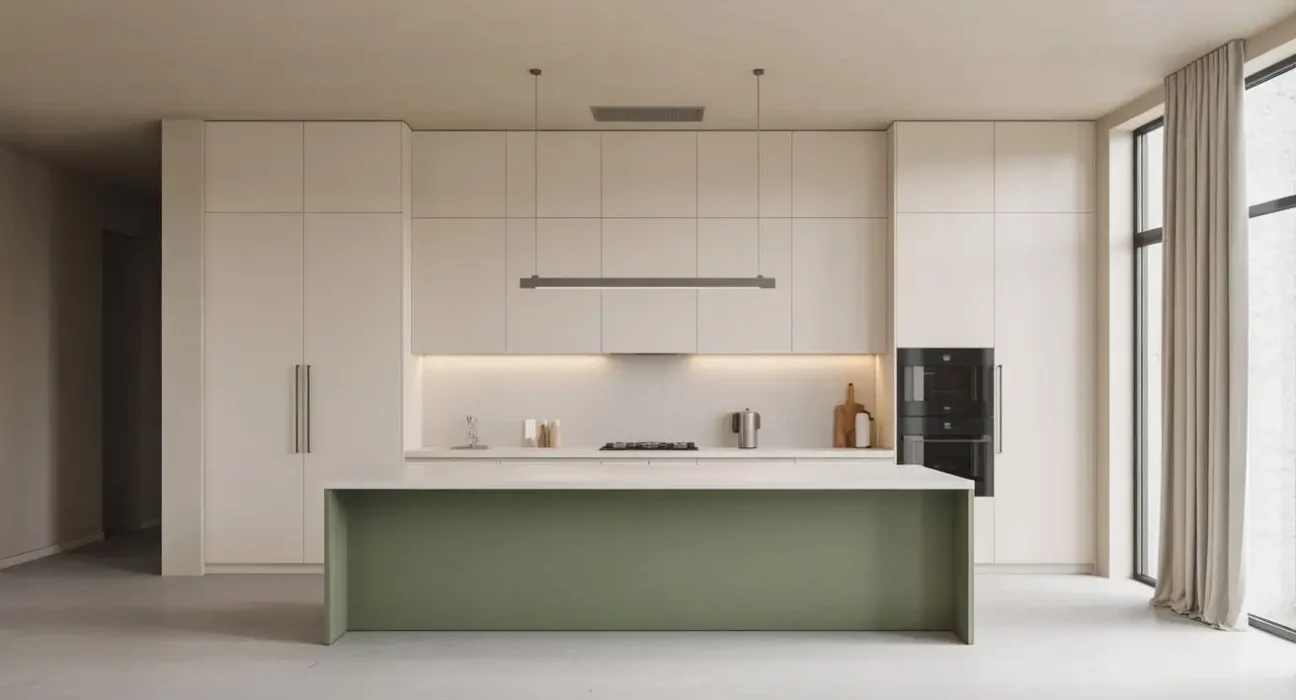Look, I get it. You’ve been scrolling through Pinterest at 2 AM (no judgment here), and suddenly you’re obsessed with green kitchen islands. Welcome to the club! Green has officially kicked out boring white and gray from the kitchen throne, and honestly? It’s about time.
I recently redid my own kitchen, and let me tell you, choosing to go green was the best decision I’ve made since buying that air fryer I swore I didn’t need. There’s something about a green island that just makes your kitchen feel alive—not in a “haunted house plant” way, but in a fresh, inviting, “yeah, I actually want to cook here” kind of way.
So buckle up, because I’m about to walk you through 15 absolutely stunning green kitchen island ideas that’ll have you calling contractors before you finish reading. From sage to emerald, matte to glossy, vintage to ultra-modern—we’re covering it all.
Sage Green Island with Brass Accents
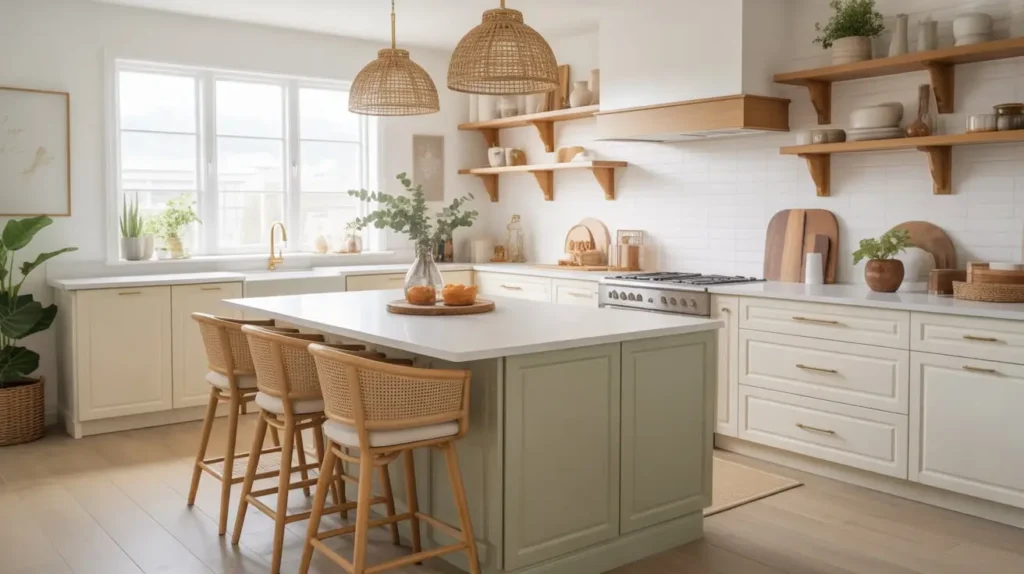
Can we just take a moment to appreciate how sage green became the design world’s sweetheart? This muted, sophisticated shade works harder than your morning coffee to create a calming atmosphere in your kitchen.
Sage green paired with brass accents is basically the design equivalent of a perfect marriage. The warm golden tones of brass hardware—think cabinet pulls, faucets, and even light fixtures—complement the earthy undertones of sage beautifully. I installed brass cup pulls on my friend’s sage island last summer, and the transformation was chef’s kiss.
Here’s why this combo wins:
- Timeless appeal: Unlike trendy colors that’ll make you cringe in five years, sage green has serious staying power
- Versatility: Works with white, cream, wood tones, and even darker cabinets
- Warm yet neutral: Brings color without overwhelming your space
- Easy to accessorize: Pairs perfectly with natural materials like wood, marble, and stone
The brass accents add just enough shine without looking too glitzy. Trust me, you don’t want your kitchen looking like a disco ball (unless that’s your vibe, then go for it).
Emerald Green Island with Marble Countertop
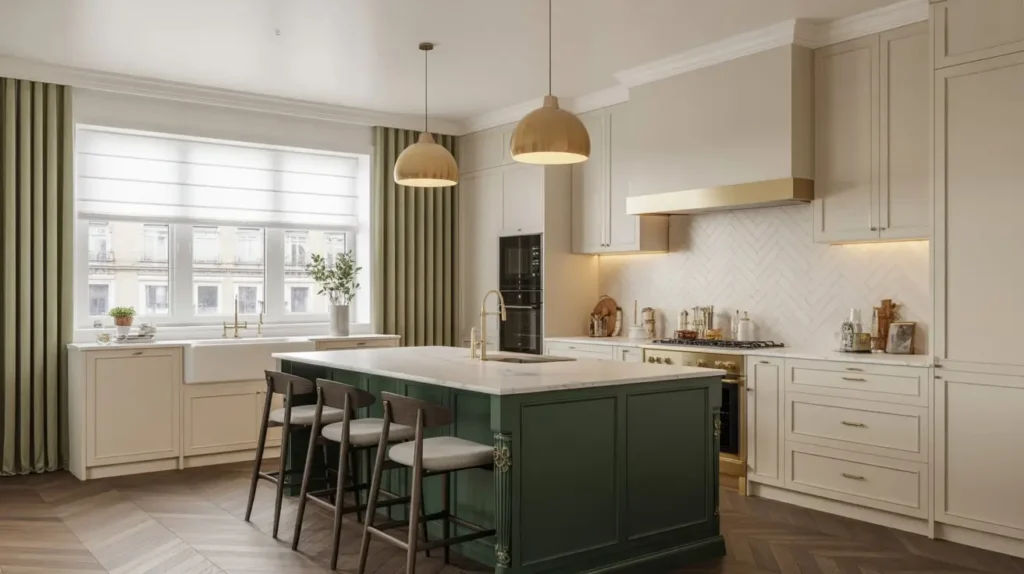
Want to make a statement that screams “I have exquisite taste”? Go emerald. This rich, jewel-toned green brings luxury and drama to your kitchen in the best possible way.
Emerald green is bold, unapologetic, and pairs like a dream with marble countertops. I’m talking classic white Carrara, dramatic black marble, or even that trendy green marble if you’re feeling extra adventurous. The veining in marble against the solid emerald creates this visual interest that you just can’t get from plain surfaces.
Fair warning though—emerald demands attention. This isn’t a shy color that blends into the background. It walks into your kitchen like it owns the place. And honestly? It kind of does.
Making Emerald Work in Your Space
Consider these points before committing:
- Lighting matters: Emerald can look darker in poorly lit spaces, so make sure you have adequate natural or artificial light
- Balance is key: Keep surrounding cabinets neutral (white, cream, or light gray) to let the island shine
- Finish carefully: A satin or semi-gloss finish enhances the richness better than flat paint
- Consider your floor: Works best with light-colored flooring to avoid a cave-like feel
Olive Green Island with Wooden Bar Stools

Olive green is like that friend who gets along with everyone—easygoing, warm, and impossibly charming. This earthy shade brings organic vibes to your kitchen without trying too hard.
Pairing an olive green island with wooden bar stools creates an inviting, natural aesthetic that makes your kitchen feel like a cozy bistro. I’ve seen this combo in both modern and traditional kitchens, and it nails it every single time.
The beauty of olive green? It has chameleon-like qualities. In morning light, it looks fresh and bright. By evening, it takes on warmer, almost golden tones. Plus, wooden stools in oak, walnut, or even painted finishes complement the earthy undertones perfectly.
Want to level this up? Add some open shelving with ceramic dishes, brass accents, and maybe a vintage-inspired rug. You’ll basically be living in a Mediterranean villa. Okay, maybe not literally, but your kitchen will definitely have those vibes 🙂
Mint Green Island in Coastal Kitchen
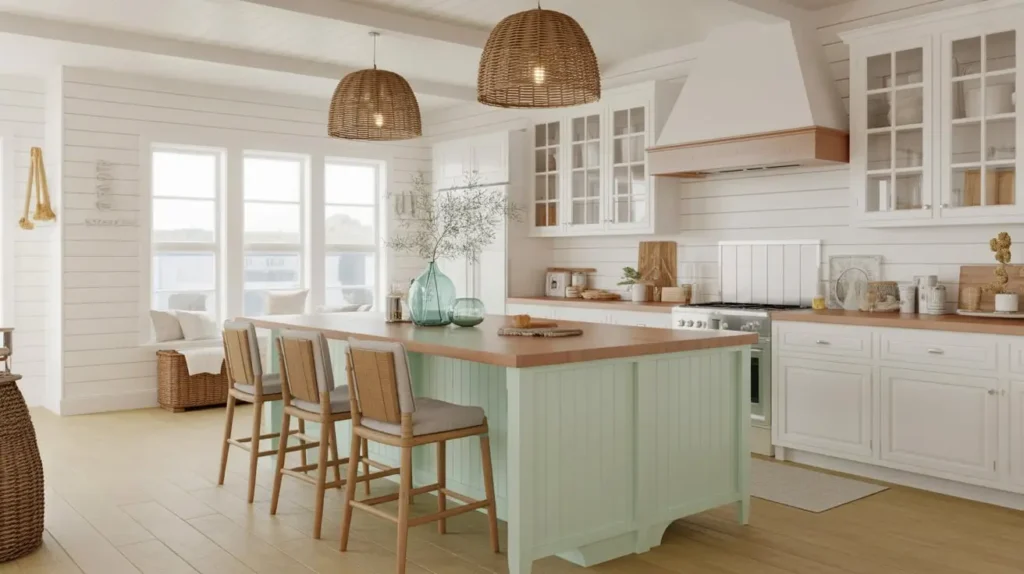
Nothing says “I summer in the Hamptons” quite like a mint green island in a coastal-inspired kitchen. This soft, refreshing shade instantly transports you to breezy beach houses and lazy seaside mornings.
Mint green works beautifully in coastal designs because it mirrors sea glass and ocean foam. Pair it with white shiplap walls, light wood floors, nautical hardware, and maybe some woven pendant lights overhead. Suddenly, you’re not just making breakfast—you’re having breakfast with an ocean view (in your imagination, but still).
Here’s what makes mint special:
- Light-reflective: Keeps spaces bright and airy
- Cheerful without being loud: Adds personality while maintaining serenity
- Pairs with crisp whites: Creates that fresh, clean coastal aesthetic
- Temperature neutral: Works in both warm and cool-toned spaces
FYI, mint can lean blue or yellow depending on the specific shade, so test your paint samples in different lighting before committing. You want sea glass, not toothpaste.
Dark Forest Green Island with Gold Hardware
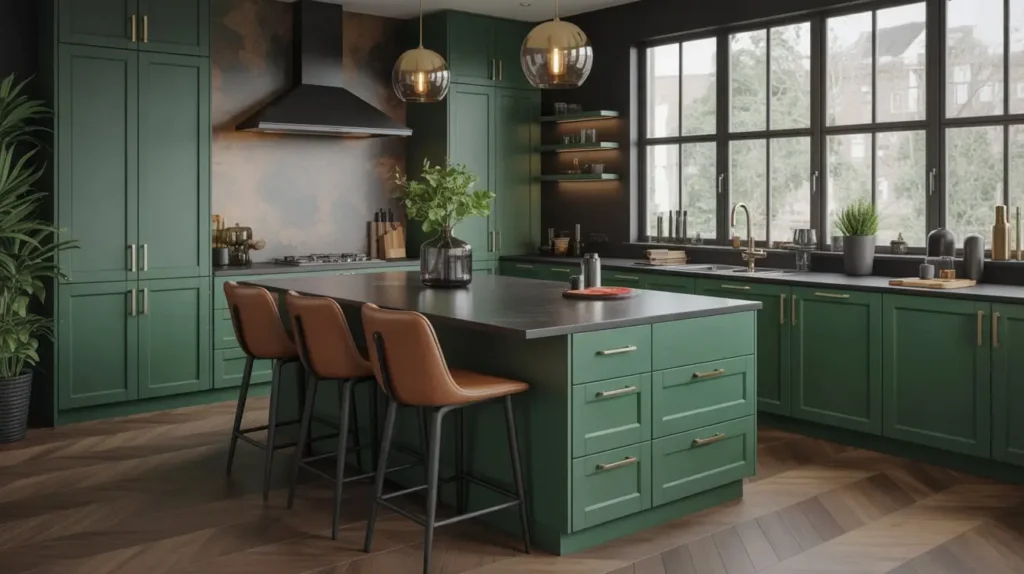
Ready to go dark and dramatic? Forest green brings moody sophistication to kitchens, creating depth and richness that lighter shades just can’t match.
Dark forest green with gold hardware is the power couple of kitchen design. This combination feels luxurious, grounded, and surprisingly versatile. I recently installed this in a client’s kitchen, and guests literally gasp when they walk in. Not to brag, but yeah, I’m kind of a genius (kidding, it’s mostly the paint doing the work).
The key to pulling off dark green successfully? Balance and lighting. You need adequate light sources—think under-cabinet lighting, pendant lights, and good natural light—to prevent your kitchen from feeling like a cave. The gold hardware adds those crucial warm accents that keep the space inviting rather than gloomy.
Tips for Dark Green Success
- Contrast with light walls: White or cream cabinets prevent the space from feeling too heavy
- Layer your lighting: Combine ambient, task, and accent lighting
- Add reflective surfaces: Glass cabinet doors, mirrors, or metallic backsplashes bounce light around
- Consider your ceiling height: Works best in kitchens with 9+ foot ceilings
Also Read: 15 Gorgeous Forest Green Kitchen Ideas with Natural Vibes
Two-Tone Kitchen with Green Island Contrast
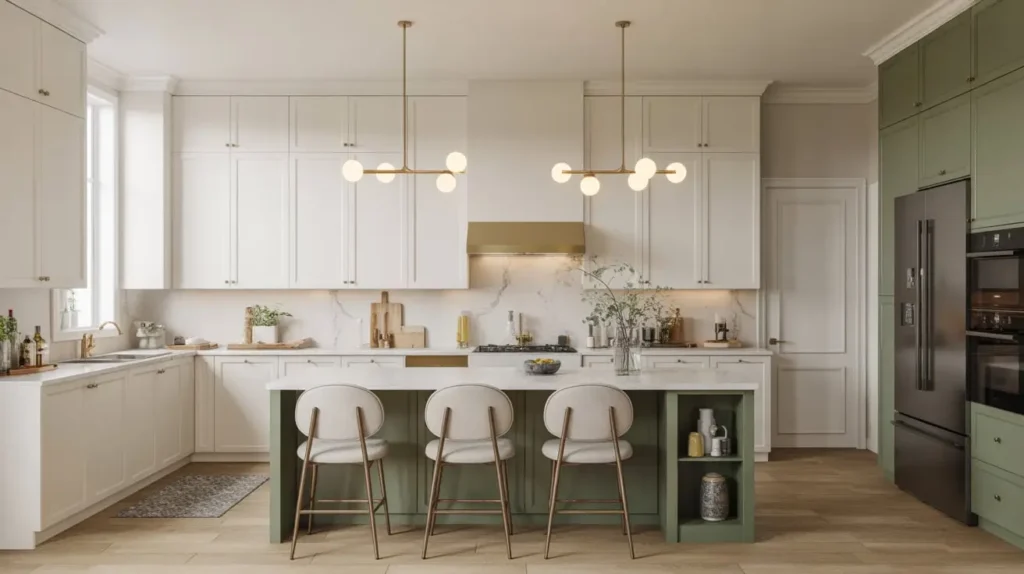
Can’t decide between keeping your cabinets classic and going bold? Have both! Two-tone kitchens let you play it safe and take risks simultaneously.
A green island creates a stunning focal point against neutral perimeter cabinets. This approach gives you that pop of color without overwhelming the entire space. I love this option for people who want to experiment with color but aren’t quite ready to commit fully. Think of it as dipping your toes in the green paint pool rather than cannonballing in.
The contrast draws the eye immediately to your island, making it the star of the show. Whether you choose sage, emerald, or hunter green, pairing it with white, cream, gray, or even navy cabinets creates visual interest and depth.
Plus, if you decide you hate the green in a few years (though why would you?), you only need to repaint the island instead of your entire kitchen. Smart, right?
Matte Green Island with Black Fixtures
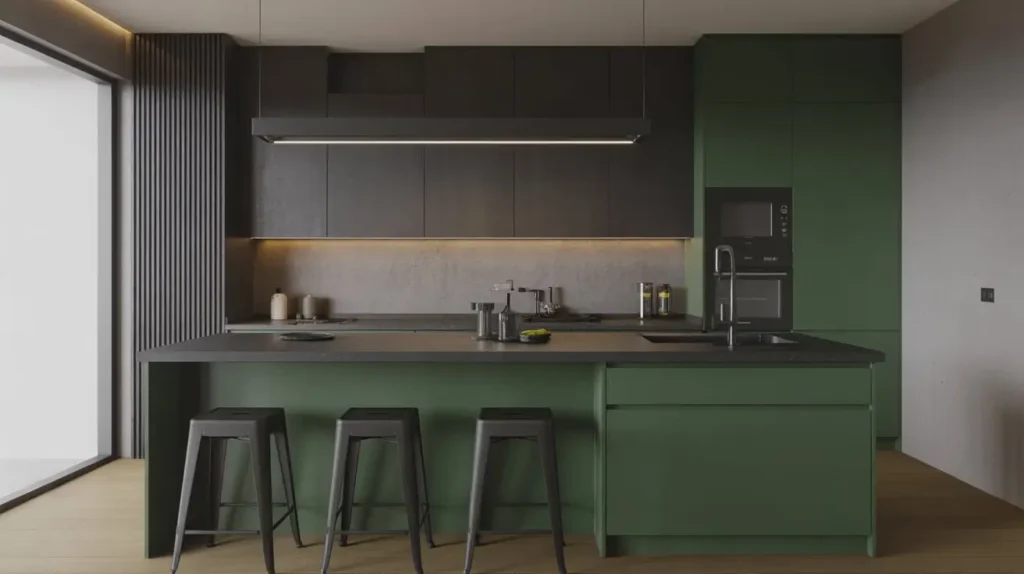
Modern, sleek, and ridiculously cool—that’s what you get with a matte green island paired with black fixtures. This combination screams contemporary sophistication.
Matte finishes have this velvety, non-reflective quality that feels current and high-end. Add black fixtures—faucets, cabinet hardware, light fixtures—and you’ve got a moody, modern aesthetic that feels both edgy and elegant. I’m personally obsessed with this look for urban lofts and industrial-style kitchens.
The matte finish also has practical benefits. It hides fingerprints and smudges better than glossy finishes (a genuine blessing if you have kids or, let’s be honest, if you’re just a messy cook like me). The black fixtures provide sharp contrast without the warmth of brass or gold, creating a more contemporary, minimalist vibe.
Color options that work beautifully in matte:
- Sage green: Soft and sophisticated
- Olive green: Earthy and modern
- Hunter green: Bold and dramatic
- Moss green: Natural and grounded
Vintage Green Island with Butcher Block Top
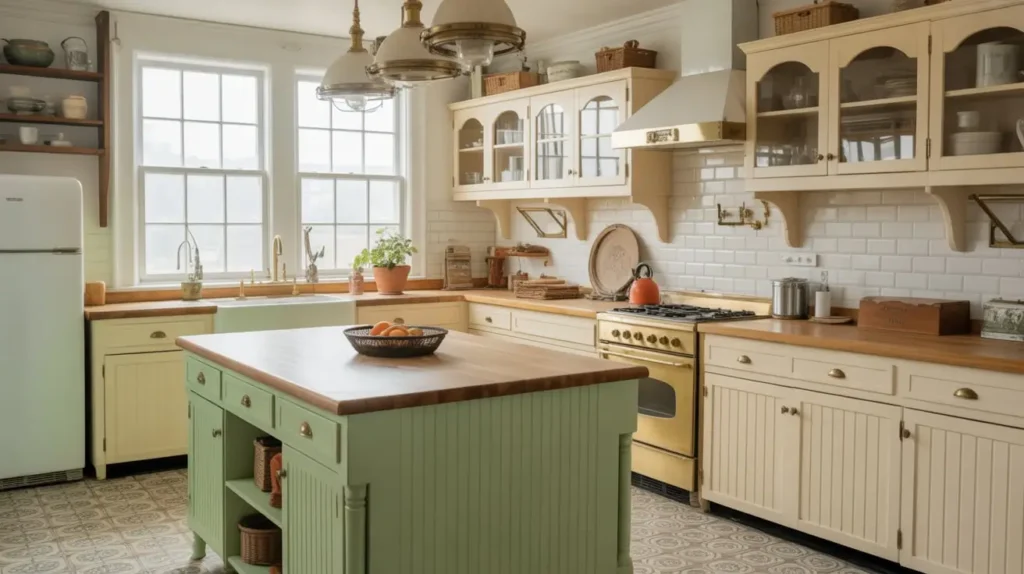
Ever wondered why vintage kitchens feel so charming? It’s the character, the warmth, the sense of history. A vintage green island with a butcher block top captures all that nostalgia while remaining completely functional.
Pairing vintage-inspired green paint with a butcher block countertop creates instant warmth and character. Think soft, slightly muted greens—nothing too bright or modern. We’re talking the kind of green you’d find in a 1940s farmhouse kitchen, where grandma made the best pies you’ve ever tasted.
The butcher block top adds practical workspace (you can chop directly on it!) and natural wood tones that complement the vintage vibe perfectly. Add some traditional cup pulls in aged brass or oil-rubbed bronze, maybe incorporate some beadboard detailing, and you’ve got yourself a kitchen with serious charm.
I refinished a vintage green island with butcher block for my own kitchen, and it’s become the heart of my home. People gravitate toward it during parties, kids do homework there, and I’ve prepped approximately one million meals on that surface. It’s functional and beautiful—the holy grail of design.
Hunter Green Island with White Cabinets
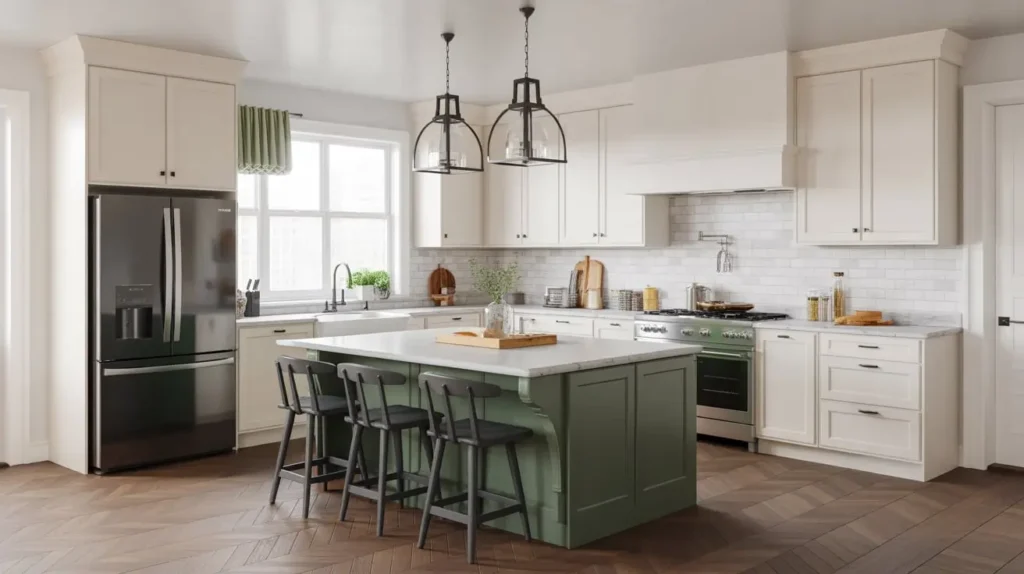
Classic, crisp, and endlessly elegant—hunter green paired with white cabinets is a combination that never goes out of style. This high-contrast pairing creates visual drama without feeling overwhelming.
Hunter green brings richness and depth while white keeps everything bright and fresh. It’s the perfect balance of bold and safe, traditional and current. I’ve seen this combo in everything from modern farmhouses to traditional colonials, and it works beautifully across different design styles.
The white cabinets reflect light around the space, preventing the darker green from feeling too heavy. Meanwhile, the hunter green island grounds the room and creates a focal point that draws the eye. Add some marble or quartz countertops, and you’ve got a kitchen that looks like it belongs in a design magazine.
Styling Your Hunter Green Island
- Hardware choices: Brushed nickel, polished chrome, or brass all work beautifully
- Backsplash options: Classic subway tile, marble slabs, or patterned cement tiles
- Accent colors: Navy, gold, natural wood, or even blush pink
- Flooring: Light wood, white oak, or classic checkerboard tile
Glossy Green Island with Pendant Lighting

Want your island to literally shine? Go glossy. A high-gloss finish on your green island creates a reflective, almost lacquered look that’s seriously eye-catching.
Glossy finishes amplify light and create depth in a way matte finishes can’t match. When you add statement pendant lighting above, the combination creates this beautiful interplay of light and reflection. I installed glossy emerald green cabinets for a client last year, and the way the pendant lights reflected off the surface was absolutely gorgeous.
The glossy finish does require more maintenance (hello, fingerprints and smudges), but the visual impact is worth it IMO. This look works especially well in modern and contemporary kitchens where you want that polished, sophisticated aesthetic.
Pendant lighting choices that complement glossy green islands:
- Brass or gold pendants: Add warmth and elegance
- Black metal pendants: Create contrast and modern edge
- Glass globe pendants: Keep things airy and light
- Geometric shapes: Emphasize contemporary style
Deep Moss Green Island in Rustic Kitchen
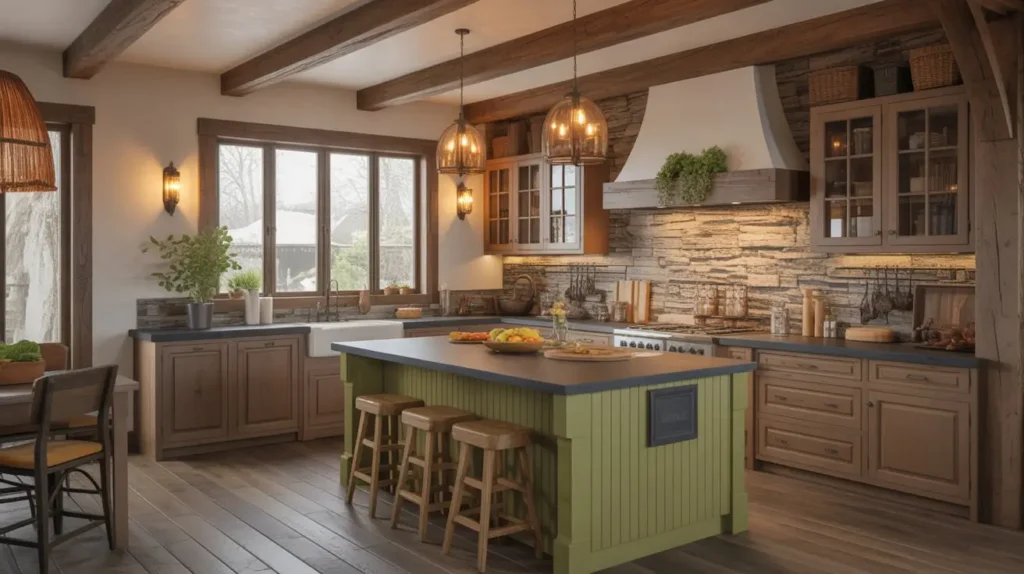
Bring the outdoors in with a deep moss green island in a rustic kitchen setting. This earthy, organic shade feels like a walk through a forest—grounding, natural, and completely calming.
Moss green has this unique ability to feel both rich and subtle simultaneously. It’s darker than sage but warmer than hunter green, sitting in this perfect middle ground that works beautifully with rustic elements like exposed beams, natural stone, and reclaimed wood.
I helped design a rustic kitchen with a moss green island last fall, and we paired it with soapstone countertops, wooden open shelving, and wrought iron hardware. The result? A kitchen that feels like it’s been there for decades, despite being brand new. There’s something about moss green that just feels timeless and authentic.
Pair it with natural materials to emphasize the rustic vibe:
- Countertops: Soapstone, butcher block, or honed granite
- Flooring: Wide-plank wood, stone tile, or terracotta
- Hardware: Wrought iron, oil-rubbed bronze, or blackened steel
- Accessories: Copper pots, ceramic dishes, woven baskets
Also Read: 15 Aesthetic Pink and Green Kitchen Ideas You’ll Adore
Pastel Green Island with Open Shelving
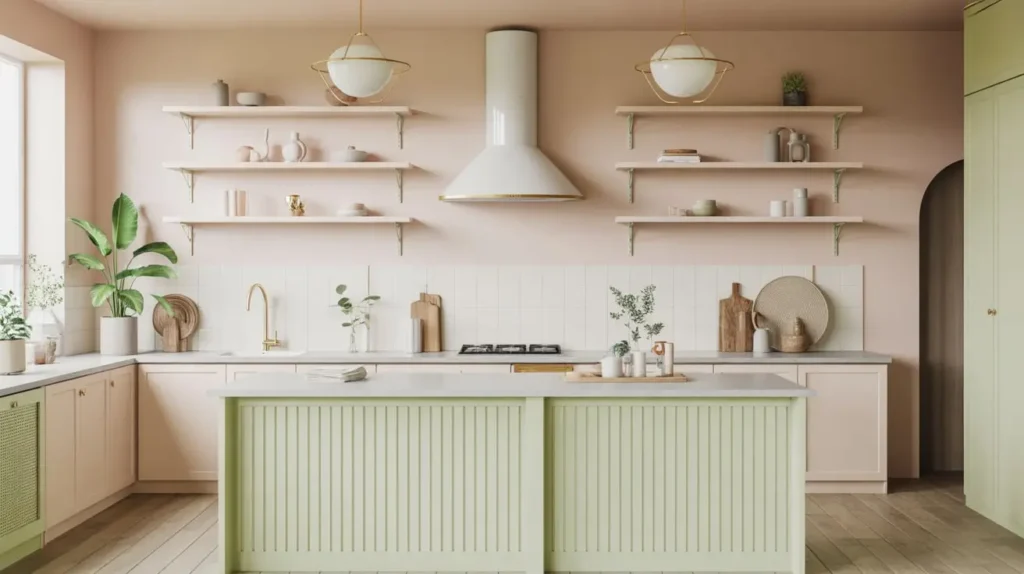
Soft, sweet, and absolutely charming—pastel green brings a gentle touch to kitchens without losing personality. This is green for people who want color but prefer whispers over shouts.
Pastel green islands with open shelving create an airy, approachable aesthetic that feels both modern and cottage-inspired. The soft color doesn’t overwhelm, making it perfect for smaller kitchens or spaces with limited natural light. The open shelving adds to this light, breathable feeling while providing practical storage.
I love pastel green for creating that “English cottage kitchen” vibe. You know, the kind where you imagine yourself baking scones on a Saturday morning while wearing a floral apron (or is that just me?). It’s inherently cheerful without being childish, soft without being boring.
Style your open shelving thoughtfully:
- Mix practical and decorative items: Dishes, glassware, cookbooks, small plants
- Create visual rhythm: Vary heights and textures
- Use cohesive colors: Whites, creams, natural wood, and touches of brass or copper
- Don’t overcrowd: Leave some breathing room for a curated look
Modern Minimalist Green Island Design
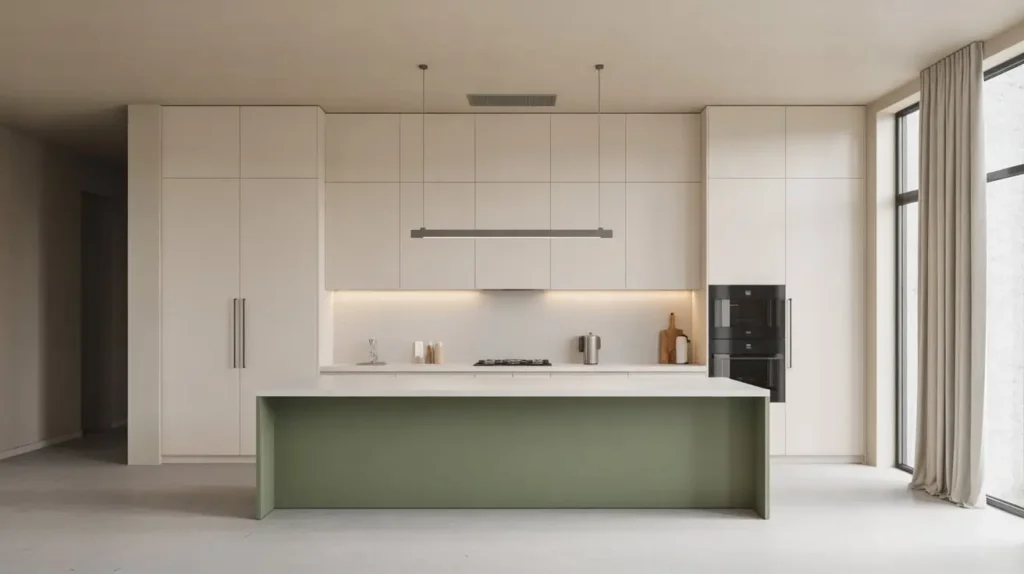
Clean lines, simple forms, no unnecessary details—that’s minimalism, baby. A modern minimalist green island proves you can have color in a streamlined space without sacrificing that sleek, uncluttered aesthetic.
The key to minimalist green islands is choosing the right shade and keeping everything else simple. Think muted sage, soft olive, or dusty eucalyptus green rather than bright or heavily saturated shades. Pair with handleless cabinets (push-to-open mechanisms), simple quartz or solid surface countertops, and minimal décor.
This approach works beautifully for people who love the calm, organized feeling of minimalism but find all-white or all-gray kitchens too sterile. The green adds life and warmth without cluttering the visual space. Less really is more here, and the green island becomes a subtle focal point rather than a loud statement piece.
Minimalist design principles to follow:
- Flat-panel or slab doors: No raised panels or ornate details
- Integrated appliances: Hide that refrigerator and dishwasher
- Simple countertops: Solid colors without busy veining or patterns
- Concealed storage: Everything has a place, nothing on display
Farmhouse Green Island with Shiplap Detailing
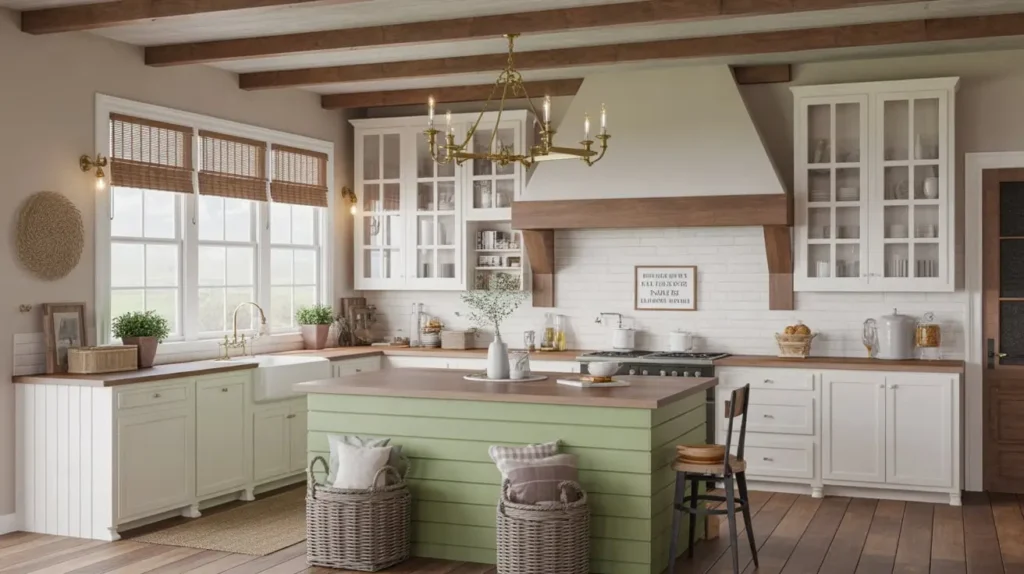
Farmhouse style refuses to go away, and honestly? I’m not mad about it. There’s something undeniably cozy about that rustic, lived-in aesthetic. A green island with shiplap detailing takes this classic style and makes it feel fresh and current.
Shiplap detailing on your island adds texture and visual interest that plain cabinet doors just can’t provide. Pair it with farmhouse green shades—think soft sage, vintage celery, or muted mint—and you’ve got yourself a kitchen that feels like home the moment you walk in.
I’ve installed shiplap on several farmhouse kitchen islands, and the detail always elevates the design. You can run the shiplap horizontally for a classic look or vertically for something a bit different. Add some traditional farmhouse sinks, apron-front details, and maybe some vintage-inspired hardware, and you’re basically living on a (very stylish) farm.
Complete the farmhouse look with:
- Countertops: Butcher block, marble, or quartz with subtle veining
- Hardware: Bin pulls, cup pulls, or simple knobs in brass or bronze
- Lighting: Industrial pendants, lantern-style fixtures, or Edison bulbs
- Accessories: Farmhouse sinks, vintage rugs, open shelving with dishes
Contemporary Green Island with Waterfall Edge
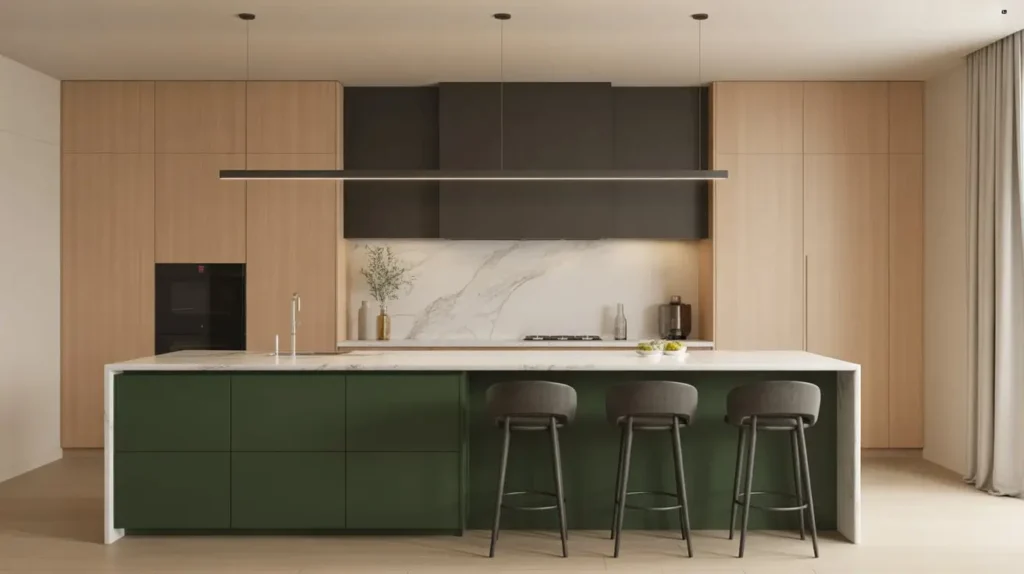
Want to end on a high note? Let’s talk waterfall edges. This contemporary design feature, where the countertop material continues down the sides of the island, creates a seamless, sophisticated look that’s absolutely stunning.
A green island with waterfall edge countertops is the ultimate contemporary statement piece. The continuous flow of material creates clean, architectural lines that emphasize modern design. When you pair this with the right shade of green—think deep forest, rich emerald, or sophisticated sage—you get a kitchen that looks like it belongs in a design magazine.
I’ll be honest, waterfall edges aren’t cheap. You’re using more material, and the fabrication requires precision and skill. But the visual impact? Totally worth it. The seamless look creates this sense of luxury and intentional design that elevated standard countertops just don’t achieve.
Best countertop materials for waterfall edges:
- Quartz: Durable, low-maintenance, consistent patterns
- Marble: Classic, elegant, natural veining (requires more maintenance)
- Quartzite: Natural stone that’s harder than marble
- Solid surface: Seamless appearance, wide color range
Contemporary styling tips:
- Keep hardware minimal: Consider handleless designs or slim profiles
- Choose sleek appliances: Stainless steel or panel-ready options
- Opt for simple lighting: Geometric pendants or linear fixtures
- Maintain clean counters: Hide small appliances and clutter
Final Thoughts on Green Kitchen Islands
So there you have it—15 absolutely gorgeous green kitchen island ideas that run the gamut from soft and subtle to bold and dramatic. Green has proven itself as way more than a passing trend. It’s versatile, timeless, and brings life to kitchens in a way neutral colors simply can’t match.
Here’s my honest take after working with green in countless kitchens: the shade matters more than you think. What looks perfect in someone else’s kitchen might not work in yours because of lighting, existing finishes, or personal style. Always—and I mean always—get paint samples and test them in your actual space. Look at them in morning light, afternoon light, and evening light. You’ll be amazed how different a shade can look at different times of day.
Don’t be afraid to commit to color. Yes, green is a choice. Yes, it requires more courage than going with safe, boring white. But that’s exactly why it’s so rewarding. Your kitchen should reflect your personality and make you happy every time you walk in. If green does that for you, then paint that island green and don’t look back.
Whether you’re drawn to the timeless elegance of sage with brass, the bold drama of emerald with marble, the coastal charm of mint, or the contemporary sophistication of a waterfall-edge design, there’s a green island style that’ll work perfectly in your kitchen. The key is choosing the shade, finish, and styling elements that align with your overall design vision and lifestyle.
And hey, if you’re still on the fence about going green, remember this: paint is changeable. You’re not tattooing your kitchen (though that would be weird). You can always repaint if you change your mind. But something tells me once you experience the magic of a gorgeous green island, you won’t want to



